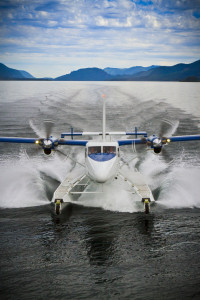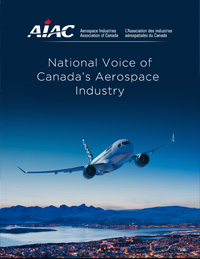National Voice of Canada’s Aerospace Industry
~By Cheryl Long
On Feb. 23, 1909, the Silver Dart lifted off the ice covering Baddeck Bay in Nova Scotia, travelling approximately 800 metres at an elevation of three to nine metres and moving at a speed of about 65 kilometres per hour. The event marked Canada’s first controlled powered flight and would pave the way for decades of innovation and development in Canada’s growing aerospace sector.
Today, Canada’s aerospace industry is made up of more than 700 companies that contribute about $28 billion to the country’s national GDP each year. Among those companies is Bombardier, the third largest commercial aircraft manufacturer in the world. The industry supports 172,000 highly skilled, high-paying jobs located in every region of Canada, and is the second most research-intensive sector in the country. Standing solidly behind those efforts is the Aerospace Industries Association of Canada (AIAC), which acts as the national voice for the industry and works to provide leadership on policy issues, increase Canada’s profile internationally and promote Canadian aerospace companies in the foreign market.
Jim Quick is AIAC’s President and CEO, joining the organization four years ago after a diverse career working for associations in the chemical sector and holding a number of senior advisory roles at the federal and provincial government levels. The AIAC, and the aerospace industry itself, has been going through a transformation, moving from an industry that focused primarily on product development and manufacturing to one that sees the importance of market access, supply chain and innovation, and is boosting capacity by implementing new programs and policies in partnership with the federal government. Growing the sector’s businesses — turning small and medium-sized companies into medium and large aerospace organizations — is one of their mandates and is considered vital if Canada is going to remain globally competitive.
The changing landscape is also true for the space industry, which AIAC also represents. “On the space side, we began our space exploration and presence when there were only two other space nations, Russia and the United States, and we were third into space,” Quick said. “Now there are more than 50 nations involved in space.”
Canada ranks fifth in world
 Today, Canada’s aerospace industry ranks fifth in the world behind the U.S., France, the United Kingdom and Germany in terms of overall revenues. When it comes to staying competitive, supply chain is “where the action is”, Quick explained. “We’ve developed and we continue to develop programs that allow our members to be more globally competitive within the global supply chain.” But globalization is a continuing challenge because, along with the traditional competitors, several emerging aerospace economies are clamoring for their piece of the pie. Countries like Brazil, India, Russia, China and Japan are eyeing the increasing demand for passenger travel and are eager to stake their claim in the market.
Today, Canada’s aerospace industry ranks fifth in the world behind the U.S., France, the United Kingdom and Germany in terms of overall revenues. When it comes to staying competitive, supply chain is “where the action is”, Quick explained. “We’ve developed and we continue to develop programs that allow our members to be more globally competitive within the global supply chain.” But globalization is a continuing challenge because, along with the traditional competitors, several emerging aerospace economies are clamoring for their piece of the pie. Countries like Brazil, India, Russia, China and Japan are eyeing the increasing demand for passenger travel and are eager to stake their claim in the market.
“If you look at the next 20 years, we’re going to have to build roughly 36,000 new aircraft globally in order to support passenger demand,” Quick said. “That represents about $5.2 trillion worth of work. What we’re trying to do is make sure that Canada gets its fair share of that.”
That’s one of the reasons why AIAC has paid close attention to recommendations coming out of recent industry-assessing reports: two reviews led by former MP David Emerson in late 2012 looking at Canada’s aerospace and space industries and a report from February 2013 on the leveraging of defence procurement by Tom Jenkins, special adviser to Canada’s minister of public works and government services.Emerson’s report looks at the changing realities of the industry and spells out two areas critical to success: developing advanced technologies and securing sales in the highly competitive global arena. Though competitiveness will be driven by private aerospace companies, public policies and programs will play a huge role in facilitating the industry’s overall prosperity, the report states.
Recommendations are 75% implemented
AIAC has been working with the federal government to help implement Emerson’s 25 recommendations, a process which is approximately 75 percent complete, Quick said. The association has also spent the past year helping to bring Jenkins’ suggestions to fruition, which encourages using key industrial capabilities to transform Canada’s defence procurement system. In the short term, the association is placing a priority on ensuring that the recommendations are implemented in the way they were intended and is already seeing a positive impact as a result.
“I think the policy framework we’ve developed through the DPS (defence procurement strategy) is very solid and very strong and certainly is some of the best that I’ve seen in my global travels,” Quick explained. “We’re extremely optimistic that this will bring about great added capability and capacity for the Canadian defence industry.”
Over the long term, AIAC is keeping an eye on global trends impacting supply chain, technology development, innovation and new advancements in space. They’ll continue to work with the government on program and policy change, always conscious of how Canada can remain a leader in aerospace, space and defence.
“On the space side, we’ll continue to develop technology for space exploration and observation,” Quick said. “As we open the North here in Canada, there are going to be significant opportunities for aerospace as well as space… These are all the things we have our eye on in the future.”
Continuing regional and national growth
Over the last three years, AIAC’s membership has grown to 120 members and represents about 90 percent of the industry. That growth has been fuelled by the association’s recent transformation as it strives to represent all sectors within the industry and all sizes of companies. In December 2013, AIAC announced the creation of its first provincial entity — AIAC Pacific. Aimed at promoting and developing aerospace business in British Columbia, AIAC Pacific helps the province’s aerospace industry access national and international programs and has developed a strong relationship with the provincial government.
 In its 2014 budget, the B.C. government announced a new $5-million, five-year program designed to help develop a strong aerospace sector within the province. It has partnered with AIAC Pacific to deliver on that commitment by working to help local companies take advantage of the industry’s global growth opportunities.The provincial organization could even serve as a model for a similar venture in other areas of Canada while keeping in mind regional differences, Quick said.
In its 2014 budget, the B.C. government announced a new $5-million, five-year program designed to help develop a strong aerospace sector within the province. It has partnered with AIAC Pacific to deliver on that commitment by working to help local companies take advantage of the industry’s global growth opportunities.The provincial organization could even serve as a model for a similar venture in other areas of Canada while keeping in mind regional differences, Quick said.
Canada has made significant contributions to the industry: being the third nation in space, developing the Canadarm, serving as home to aircraft manufacturer Bombardier, working with the government on the creation of a new space station, maintaining a world-leading regulatory framework and investing in ongoing research and development. Facing the challenges of an aging labour demographic is another mandate, and AIAC is working to reach younger generations to spark an interest in the aerospace and space industries. They’ve gone into schools to make industry announcements, Quick said, and use the opportunity to stress the importance of STEM (Science, Technology, Engineering, Mathematics) education as a path to future careers.
“There’s now a global approach to our industry and we’re really going to have to look inward at ourselves to make sure we remain competitive,” Quick said. “What’s really helping us is that we have a willing partner in the Government of Canada.”
To learn more about AIAC and Canada’s role in the aerospace and space sectors, visit www.aiac.ca.








